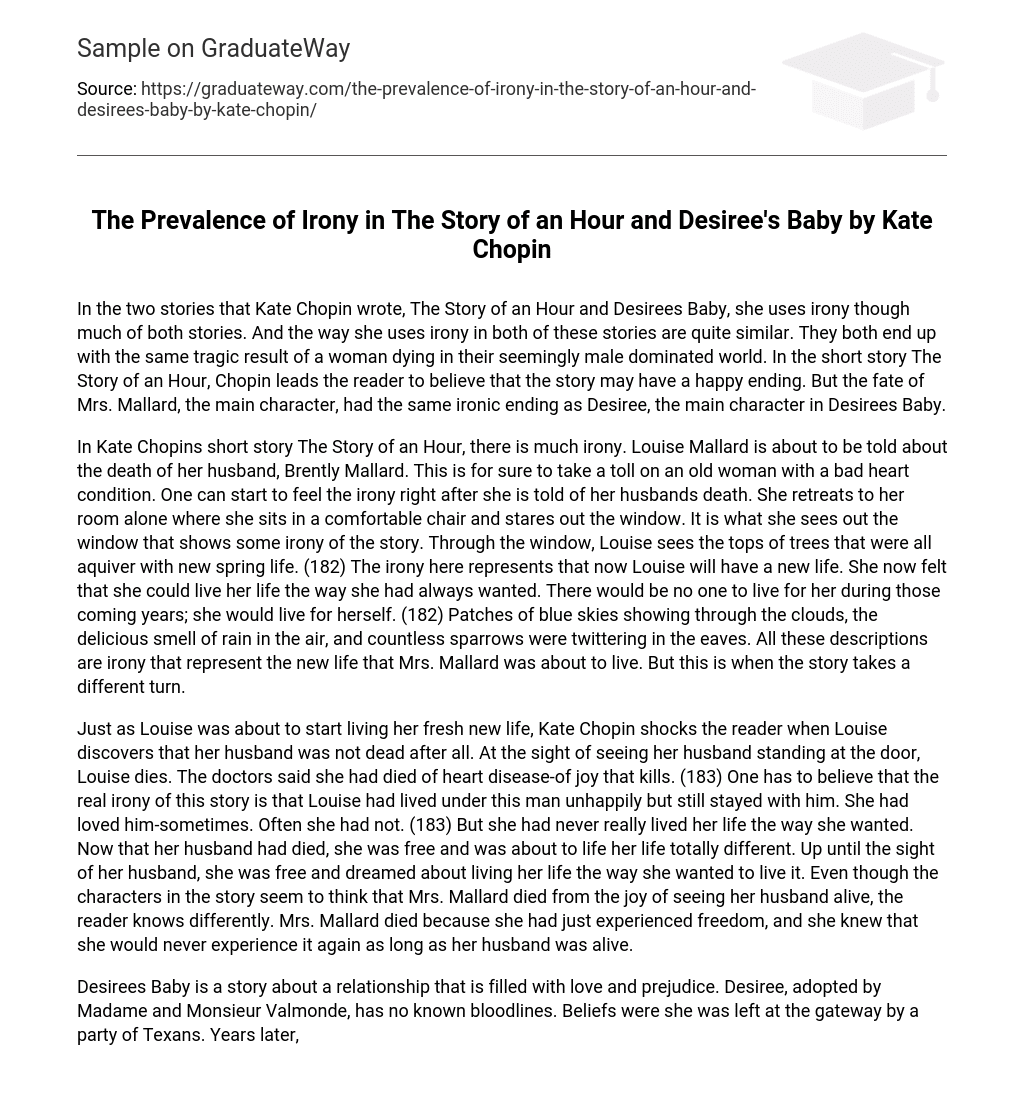In her two stories, The Story of an Hour and Desirees Baby, Kate Chopin employs irony extensively. The utilization of irony is strikingly similar in both stories, leading to the tragic demise of a woman in their seemingly male-dominated society. The Short story, The Story of an Hour, initially suggests a possible happy ending. However, the fate of Mrs. Mallard, the main character, parallelled the ironic ending of Desiree, the main character in Desirees Baby.
In Kate Chopin’s short story “The Story of an Hour,” there is a notable amount of irony. Louise Mallard, an elderly woman with a frail heart, is about to receive the news of her husband’s death. It is certain that this news will have a significant impact on her. The irony becomes apparent immediately after she is informed about her husband’s demise. Seeking solace, she retreats to her room where she sits in a comfortable chair and gazes out of the window. It is through this window that she witnesses the irony of the story. Outside, she sees vibrant trees, brimming with new life that spring brings (182). This irony reflects the fact that Louise will now have a new lease on life. She feels empowered to live her life in the way she has always desired. The upcoming years would solely be for her, as there would be no one else to live for (182). The cloudy sky giving way to patches of blue, the tantalizing scent of impending rain, and the cheerful chirping of sparrows perched in the eaves – all these descriptions embody the ironic representation of the new life that Mrs. Mallard is about to embark upon. However, this is precisely when the story takes an unexpected twist.
As Louise prepared to begin her new life, Kate Chopin startles the reader by revealing that her husband is actually alive. Upon seeing him at the door, Louise dies. The doctors determine that she died of heart disease caused by overwhelming joy (183). The true irony of the story lies in the fact that Louise had remained unhappily married to this man, despite loving him sporadically and often feeling unhappy (183). However, she had never truly lived life according to her own desires. With her husband’s supposed death, she became free and anticipated a completely different existence. Until the moment she saw her husband, she was free and dreamed of living on her own terms. While the characters in the story believe that Mrs. Mallard died from the joy of witnessing her husband’s presence, the reader knows otherwise. Mrs. Mallard died because she had just tasted freedom and recognized that it would forever be out of her reach as long as her husband was alive.
Desiree’s Baby explores a relationship infused with both love and prejudice. Adopted by Madame and Monsieur Valmonde, Desiree’s true lineage is unknown, with beliefs suggesting she was abandoned by Texans. Years later, as a grown woman, Desiree marries the wealthy Armand Aubigny, a slave owner. Initially, they appeared blissful together, with Armand disregarding her mysterious heritage. He saw no importance in her namelessness compared to his ability to grant her one of Louisiana’s oldest and proudest names (178). However, tragedy strikes their relationship three months after their first child’s birth, when it is revealed that the baby is of mixed race. Armand turns his back on both the child and Desiree, unable to bear the impurity tarnishing his prestigious family name.
Desiree denies his accusations. Look at my hand whiter than yours, Armand. (180) This moment in the story is where Chopin employs a great deal of irony. The reader naturally assumes that Desiree has a mixed background since she was abandoned and lacked proof of her heritage. Armand, on the other hand, with his family lineage, certainly does not have any mixed blood. Desiree is ultimately forced to leave with their child and makes her way toward a sluggish bayou where she disappears forever. Armand decides to separate from his wife and child in order to preserve the honor of his family name. The irony that Chopin employs in the narrative is that later on, Armand discovers a letter written by his mother that reveals he is the one who has mixed race heritage, not Desiree. The reader can imagine the internal turmoil that Armando must have experienced upon learning this secret.
In these two short stories, Kate Chopin employs irony to create a shocking effect for the reader. In The Story of an Hour, Mrs. Mallard believes she will finally start a new life, only to have her hopes crushed when she sees her husband at the door and realizes her freedom is gone forever. Similarly, in Desirees Baby, Armand discovers that he is the carrier of the black gene that makes their child of mixed race, but it is too late as his wife and child have already left and died. Both stories end with unexpected twists, leaving readers in disbelief.





